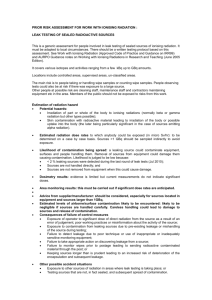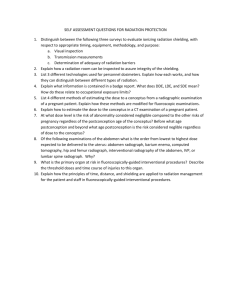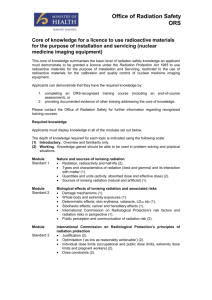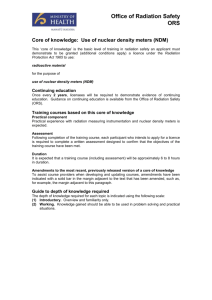Work with sealed sources of radioactivity
advertisement
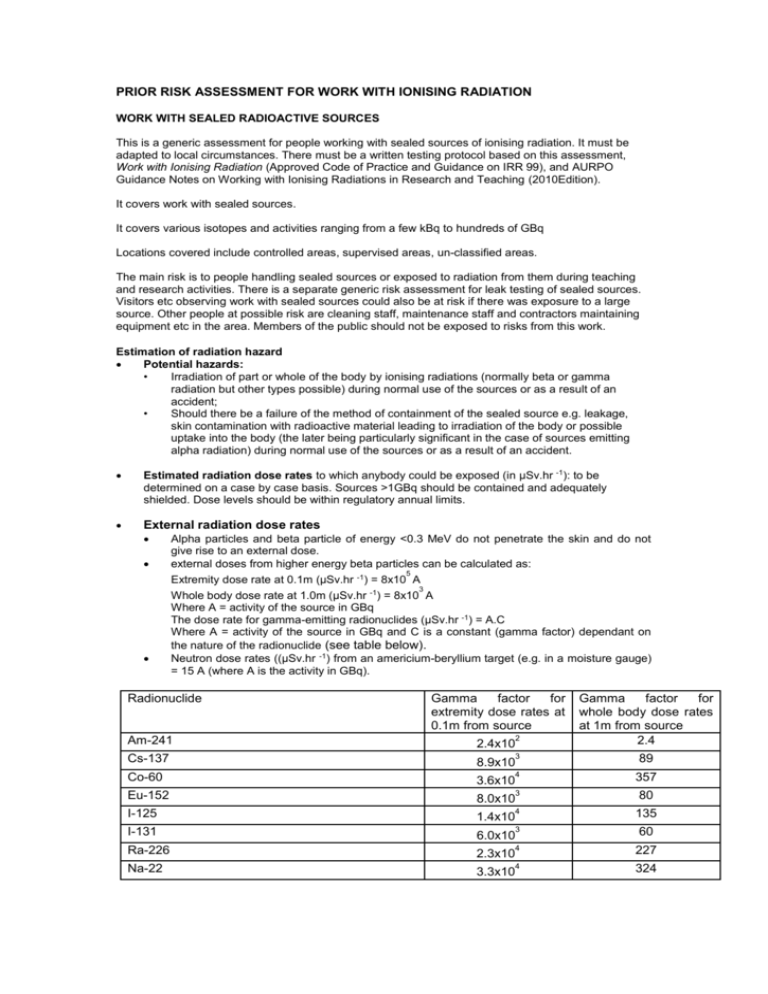
PRIOR RISK ASSESSMENT FOR WORK WITH IONISING RADIATION WORK WITH SEALED RADIOACTIVE SOURCES This is a generic assessment for people working with sealed sources of ionising radiation. It must be adapted to local circumstances. There must be a written testing protocol based on this assessment, Work with Ionising Radiation (Approved Code of Practice and Guidance on IRR 99), and AURPO Guidance Notes on Working with Ionising Radiations in Research and Teaching (2010Edition). It covers work with sealed sources. It covers various isotopes and activities ranging from a few kBq to hundreds of GBq Locations covered include controlled areas, supervised areas, un-classified areas. The main risk is to people handling sealed sources or exposed to radiation from them during teaching and research activities. There is a separate generic risk assessment for leak testing of sealed sources. Visitors etc observing work with sealed sources could also be at risk if there was exposure to a large source. Other people at possible risk are cleaning staff, maintenance staff and contractors maintaining equipment etc in the area. Members of the public should not be exposed to risks from this work. Estimation of radiation hazard Potential hazards: • Irradiation of part or whole of the body by ionising radiations (normally beta or gamma radiation but other types possible) during normal use of the sources or as a result of an accident; • Should there be a failure of the method of containment of the sealed source e.g. leakage, skin contamination with radioactive material leading to irradiation of the body or possible uptake into the body (the later being particularly significant in the case of sources emitting alpha radiation) during normal use of the sources or as a result of an accident. Estimated radiation dose rates to which anybody could be exposed (in µSv.hr -1): to be determined on a case by case basis. Sources >1GBq should be contained and adequately shielded. Dose levels should be within regulatory annual limits. External radiation dose rates Alpha particles and beta particle of energy <0.3 MeV do not penetrate the skin and do not give rise to an external dose. external doses from higher energy beta particles can be calculated as: 5 Extremity dose rate at 0.1m (µSv.hr -1) = 8x10 A 3 Whole body dose rate at 1.0m (µSv.hr -1) = 8x10 A Where A = activity of the source in GBq The dose rate for gamma-emitting radionuclides (µSv.hr -1) = A.C Where A = activity of the source in GBq and C is a constant (gamma factor) dependant on the nature of the radionuclide (see table below). Neutron dose rates ((µSv.hr -1) from an americium-beryllium target (e.g. in a moisture gauge) = 15 A (where A is the activity in GBq). Radionuclide Gamma factor for extremity dose rates at 0.1m from source 2 Am-241 2.4x10 Cs-137 8.9x10 Co-60 Eu-152 I-125 Gamma factor for whole body dose rates at 1m from source 2.4 3 89 4 357 3 80 4 135 3 60 4 227 4 324 3.6x10 8.0x10 1.4x10 I-131 6.0x10 Ra-226 2.3x10 Na-22 3.3x10 Likelihood of contamination being spread: a leaking source could contaminate equipment, surfaces and people handling them. Removal of sources from equipment could damage them causing contamination. Likelihood is judged to be low as: • < 2% of sealed sources were detected or suspected of leakage during the last round of leak tests (Jul 2010); • Sources are not handled directly; and • Sources are not removed from equipment unless absolutely necessary. Dosimetry results: current measurements do not indicate significant doses to radiation workers. Area monitoring results: this should be carried out if significant dose rates are anticipated. Advice from supplier/manufacturer: should be considered, especially for sources located in equipment and sources larger than 1GBq. Estimated levels of airborne/surface contamination likely to be encountered: likely to be negligible if sources are handled carefully. Careless handling could lead to damage to source and release of minor surface contamination. Consequences of failure of control measures (see below): • Exposure of operator to significant dose of direct radiation from the source as a result of an error of judgement, poor working practices or misinformation about the activity of the source; • Failure to provide adequate information, instruction & training about risks and workplace precautions leading to mishandling of sources; • Failure of students or researchers to follow protocols with subsequent exposure to radiation; • Poor accountancy procedures leading to loss of sources; • Exposure to contamination from leaking sources due to pre-existing leakage or mishandling of the source; • Failure to detect leakage due to poor technique or use of inappropriate or inadequately sensitive monitoring equipment.; • Failure to take appropriate action on discovering leakage from a source; and • Keeping sources longer than is prudent leading to an increased risk of deterioration of the encapsulation and subsequent leakage. Other possible accident situations • Exposure to other sources of radiation in areas where work is taking place; • Failure of electrical or mechanical systems in which source is located: • Serious impact on source; • Leakage or explosion of sources that emit alpha radiation due to accumulation of helium; • Fire or flood resulting in degradation of source and release of radioactivity; • Malicious or irresponsible tampering with sources; or • Wrong categorisation of unsealed sources as sealed. Low if control measures are in place and work is carried out by or supervised by competent persons. LEVEL OF RISK: Estimation of any non radiation hazards Possible hazards are: • Fire and flood; • Electrical hazards from equipment sources are located in; • Other equipment related hazards (heat, mechanical hazards, sharp surfaces etc); • Hazards from manual handling of sources and their containers; • Toxic chemical hazards from leaking sources (e.g. americium & beryllium); and • Physical hazards in the environment in which the testing takes place (slip, trip & fall, contact hazards etc). LEVEL OF RISK from these hazards should normally be low and under control. Detailed consideration of these risks is beyond the scope of this assessment. Significant risks should be the subject of separate risk assessments. CONTROL MEASURES: Dose constraints. Doses must be constrained so that in practice doses received should be low. Workers should avoid exposure to radiation from high activity sources. Dosimetry requirements: these should be determined on a case by case basis and should be appropriate for the work area and the type of sources handled. Undergraduate students should not undertake activities requiring dosimetry. Designation of areas as Controlled or Supervised: criteria set out in Regulation 16 of the Ionising Radiations Regulations should be applied on a case by case basis. Registration & designation of workers: Only authorised persons approved by the Department may work with sealed sources. A list must be kept. Designation as a classified worker should not normally be required given the activities currently being undertaken in the University. Laboratory design features: These must be determined case by case basis. Ventilation/engineering controls / interlocks. Where sources are located in equipment, a specific assessment must be carried out to determine whether engineering controls are necessary; Where practicable, sources used in undergraduate teaching experiments should be encased in holders or equipment in such a way that direct exposure to the source is prevented - anti-tamper devices must be fitted if necessary; Where necessary, there should be mechanisms that indicate when sources are in the exposed position; Where necessary, it must be possible, in the case of equipment failure, to return sources to their shielded positions without exposing operators to significantly increased dose rates; Access restriction/ warning devices/signs, screens etc: This should be appropriate for the work areas in question; Areas where the work takes place must be designated “supervised” or “controlled” as necessary (see IRR99 and Procedures and Guidance, Designated Areas); and Sources and equipment that they are located in should be clearly marked with the radioactive trefoil sign. Safe systems of work (effectiveness & suitability): Use of sealed sources must be carried out by trained, competent persons or under the direct supervision of competent persons using approved techniques; There should be written protocols for work with sealed sources and also for assembly of equipment, dismantling equipment and removal of sources, maintenance procedures etc.; If there is any doubt about assessments or control measures, the University Radiation Protection Officer must be consulted; Sources must be correctly identified with unique identification codes; Departments must ensure that all requirements of authorisations made by the Environment Agency under the EPR10 are complied with; Local Rules appropriate for the work areas visited must be followed; Sealed sources must not be handled directly – forceps, tongs (long-handled if appropriate) etc must be used; Sources that are suspected of leaking must be dealt so that spread of contamination is minimised; an action plan for the further management of the source and the decontamination of surfaces and articles which it may have been in contact with must be drawn up; Source accountancy procedures must be in place. Checks for the presence of the sources should be made and recorded at appropriate intervals - once a month is normal but once a quarter is permissible if they are kept in a secure store where tampering would be readily noticed (“loose” sources used for undergraduate teaching must be accounted for at the end of each session); and Leak tests must be carried out every two years and records kept. Personal protective equipment: as appropriate to the area in question and in compliance with Local Rules. Monitoring procedures (before during & after experiments): Work areas should be monitored periodically for possible contamination using suitable monitors; and Suitable monitors must be used during work with sealed sources as specified by specific risk assessments. Maintenance/testing procedures: Equipment containing sealed sources must be inspected and maintained as necessary. Faulty equipment must not be used but must be repaired or replaced. monitors must be recalibrated by competent persons every year. Storage & disposal of sources: Sealed sources must be stored in a safe and secure place; Appropriate security measures must be in place; Source accountancy procedures must be in place. Departments should have a policy of disposing of sources that exceed their recommended working life; and Condemned sources must be disposed of in a safe manner by approved contractors within as soon as practicable. Training requirements All persons using sealed sources must be competent to do so or be supervised by competent persons; and Competence issues should be referred to the University Radiation Protection Adviser where necessary. Health surveillance (including alteration of working conditions of pregnant/breastfeeding workers or other persons at increased risk) The need for health surveillance must be assessed on a case by case basis. It is unlikely to be required given the current use of sealed sources in the University; Exposure of pregnant or breastfeeding women to significant doses of radiation must be avoided if practicable and must not exceed permissible annual limits. Dose limits: investigational level for workers It is good practice for RPSs & the University RPO to investigate any doses that are unexpected or significantly above background. However, the URPO will instigate a formal investigation if doses (single or accumulated) exceed the following limits (see Procedures and Guidance, Dose Limits) in a calendar year: Classified Workers: 3/10 of any of the dose limits for Classified Workers; or Other workers: any of the limits for Members of the Public. Emergency procedures and mitigation of the consequences of accidents There must be an action plan for specifying action to be taken in the case of suspected significant exposure to radiation or contamination from a sealed source; If necessary, the advice of the University Radiation Protection Adviser should be sought; Equipment necessary for decontamination of surfaces and equipment must be readily available; People working in the facilities must be instructed in the action to be taken in an emergency; Where practicable, emergency procedures should be tested periodically. ACTION PLAN An Action Plan must be drawn up if the risk assessment identifies any actions that is needed to reduce risks to as low a level as is reasonably practicable (ALARP). Guidelines in Instructions for Use of Radioactive Sealed Sources must be followed. The plan must specify who will carry out the actions identified, a timescale for completion; and who is responsible for monitoring the completion of the work.
